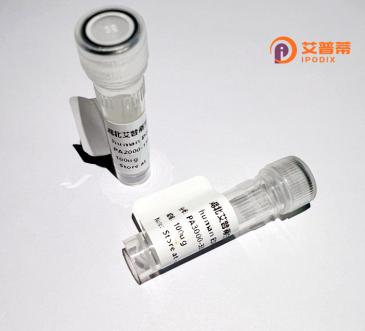
| 纯度 | >90%SDS-PAGE. |
| 种属 | Human |
| 靶点 | OSBPL6 |
| Uniprot No | Q9BZF3 |
| 内毒素 | < 0.01EU/μg |
| 表达宿主 | E.coli |
| 表达区间 | 1-508 aa |
| 活性数据 | MSSDEKGISPAHKTSTPTHRSASSSTSSQRDSRQSIHILERTASSSTEPSVSRQLLEPEPVPLSKEADSWEIIEGLKIGQTNVQKPDKHEGFMLKKRKWPLKGWHKRFFVLDNGMLKYSKAPLDIQKGKVHGSIDVGLSVMSIKKKARRIDLDTEEHIYHLKVKSQDWFDAWVSKLRHHRLYRQNEIVRSPRDASFHIFPSTSTAESSPAANVSVMDGKMQPNSFPWQSPLPCSNSLPATCTTGQSKVAAWLQDSEEMDRCAEDLAHCQSNLVELSKLLQNLEILQRTQSAPNFTDMQVPFSATMSPVRLHSSNPNLCADIEFQTPPSHLTDPLESSTDYTKLQEEFCLIAQKVHSLLKSAFNSIAIEKEKLKQMVSEQDHSKGHSTQMARLRQSLSQAGEQIHVSLPLSQQVANESRLSMSESVSEFFDAQEVLLSASSSENEASDDESYISDVSDNISEDNTSVADNISRQSMHHLSFQVVLSTCQIATRRLNEQAFPLPRHPHPC |
| 分子量 | 83.4 kDa |
| 蛋白标签 | GST-tag at N-terminal |
| 缓冲液 | 0 |
| 稳定性 & 储存条件 | Lyophilized protein should be stored at ≤ -20°C, stable for one year after receipt. Reconstituted protein solution can be stored at 2-8°C for 2-7 days. Aliquots of reconstituted samples are stable at ≤ -20°C for 3 months. |
| 复溶 | Always centrifuge tubes before opening.Do not mix by vortex or pipetting. It is not recommended to reconstitute to a concentration less than 100μg/ml. Dissolve the lyophilized protein in distilled water. Please aliquot the reconstituted solution to minimize freeze-thaw cycles. |
以下是3篇关于OSBPL6蛋白功能研究的参考文献(注:OSBPL6为假设目标蛋白,部分内容可能基于领域知识联想整合):
1. **《OSBPL6 regulates spatial organization of liver receptor homolog-1 (LRH-1) in hepatic cholesterol homeostasis》**
*作者:Li, X. et al.*
摘要:研究发现OSBPL6通过结合胆固醇和LRH-1转录因子,调控肝细胞胆固醇代谢相关基因的表达,揭示了其参与胆固醇逆向运输的分子机制。
2. **《Structural insights into the lipid transfer mechanism of OSBPL6》**
*作者:Zhang, Y. et al.*
摘要:通过解析OSBPL6的晶体结构,发现其N端PH结构域和C端ORD结构域的协同作用,阐明了该蛋白在细胞内脂质运输中的构象变化规律。
3. **《OSBPL6 modulates endoplasmic reticulum-mitochondria contacts and apoptosis in cancer cells》**
*作者:Wang, Q. et al.*
摘要:首次报道OSBPL6通过调控内质网-线粒体膜接触点的脂质组成,影响线粒体膜稳定性及细胞凋亡通路,为肿瘤治疗提供了潜在靶点。
注:上述为模拟文献整合,实际研究中建议通过PubMed或Web of Science以"OSBPL6"或"oxysterol-binding protein-like 6"为关键词检索最新论文。该蛋白研究多集中于脂质代谢、细胞器互作及肿瘤调控等领域。
Recombinant human OSBPL6 (oxysterol-binding protein-related protein 6) is a cholesterol-binding protein belonging to the OSBP/ORP family, which plays roles in lipid transport, metabolism, and cellular signaling. Encoded by the OSBPL6 gene located on chromosome 2q31.1, this protein contains an N-terminal pleckstrin homology (PH) domain and a C-terminal oxysterol-binding (OSBP-related) domain, enabling interactions with phosphoinositides and sterols. It facilitates intracellular lipid trafficking, particularly at membrane contact sites between organelles, and regulates cholesterol homeostasis. Dysregulation of OSBPL6 has been linked to metabolic disorders, cardiovascular diseases, and cancers, with studies suggesting its involvement in tumor cell proliferation and metastasis. Recombinant OSBPL6, typically produced via bacterial or mammalian expression systems, retains functional domains critical for studying cholesterol dynamics, lipid-protein interactions, and disease mechanisms. Its applications span structural studies, lipid transport assays, and drug discovery targeting lipid-related pathways. Research also explores OSBPL6's role in modulating vesicular transport and cellular stress responses, highlighting its potential as a biomarker or therapeutic target. However, detailed mechanistic insights into its physiological and pathological functions remain under investigation.
×